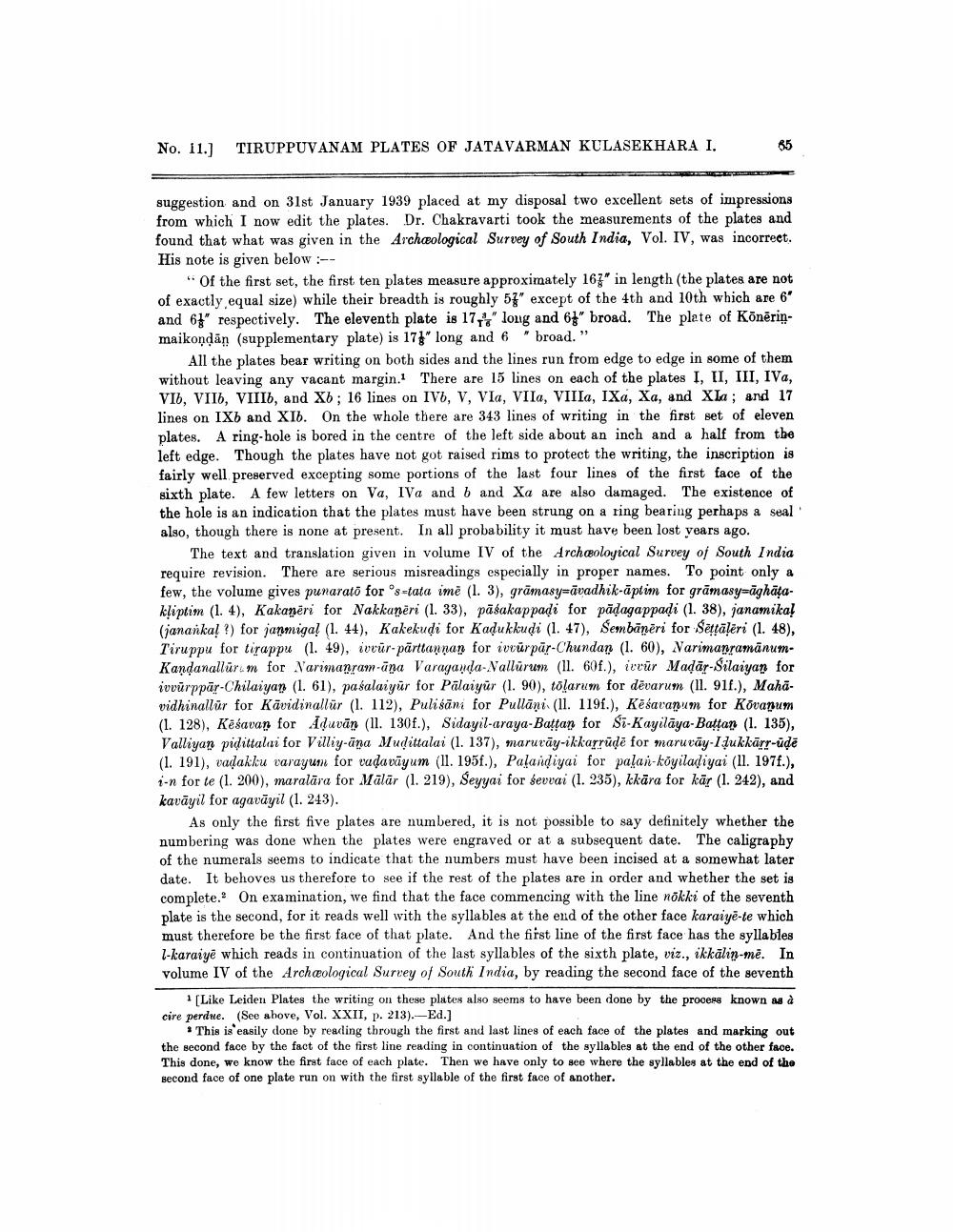________________
No. 11.]
TIRUPPUVANAM PLATES OF JATAVARMAN KULASEKHARA I.
65
suggestion and on 31st January 1939 placed at my disposal two excellent sets of impressions from which I now edit the plates. Dr. Chakravarti took the measurements of the plates and found that what was given in the Archaeological Survey of South India, Vol. IV, was incorrect. His note is given below:--
"Of the first set, the first ten plates measure approximately 167" in length (the plates are not of exactly equal size) while their breadth is roughly 57" except of the 4th and 10th which are 6" and 6" respectively. The eleventh plate is 17" long and 63" broad. The plate of Kōnērinmaikonḍān (supplementary plate) is 173" long and 6" broad."
All the plates bear writing on both sides and the lines run from edge to edge in some of them without leaving any vacant margin. There are 15 lines on each of the plates I, II, III, IVa, VIb, VIIb, VIIIb, and Xb; 16 lines on IVb, V, VIa, VIIa, VIIIa, IXa, Xa, and XLa; and 17 lines on IX and XIb. On the whole there are 343 lines of writing in the first set of eleven plates. A ring-hole is bored in the centre of the left side about an inch and a half from the left edge. Though the plates have not got raised rims to protect the writing, the inscription is fairly well preserved excepting some portions of the last four lines of the first face of the sixth plate. A few letters on Va, IVa and b and Xa are also damaged. The existence of the hole is an indication that the plates must have been strung on a ring bearing perhaps a seal also, though there is none at present. In all probability it must have been lost years ago.
The text and translation given in volume IV of the Archaeological Survey of South India require revision. There are serious misreadings especially in proper names. To point only a few, the volume gives punarato for 's-tata ime (1. 3), grāmasy-avadhik-aptim for grāmasy-aghāṭakliptim (1. 4), Kakaneri for Nakkaneri (1. 33), pāśakappadi for padagappadi (1. 38), janamika! (jananka!?) for janmigal (1. 44), Kakekuḍi for Kadukkudi (1. 47), Sembāņēri for Settaleri (1. 48), Tiruppu for tirappu (1. 49), ivvür-parttannan for ivvurpāṛ-Chundan (1. 60), NarimanṛamanumKandanallurm for Narimanram-ana Varaganda-Nallurum (11. 60f.), ivvür Maḍār-Silaiyan for ivvurppar-Chilaiyan (1. 61), pasalaiyur for Palaiyur (1. 90), tolarum for devarum (11. 91f.), Mahavidhinallur for Kävidinallür (1. 112), Pulisani for Pullani (11. 1191.), Kesavanum for Kōvanum (1. 128), Kesavan for Aduvan (11. 130f.), Sidayil-araya-Baṭṭan for Si-Kayilaya-Baṭṭan (1. 135), Valliyan pidittalai for Villiy-ana Muḍittalai (1. 137), maruvāy-ikkaṛrūdē for maruvay-Iḍukkārṛ-ūdē (1. 191), vadakku varayum for vaḍavayum (11. 195f.), Palandiyai for palan-kōyiladiyai (11. 197f.), i-n for te (1. 200), maralāra for Mälar (1. 219), Seyyai for sevvai (1. 235), kkāra for kār (1. 242), and kavayil for agavayil (1. 243).
As only the first five plates are numbered, it is not possible to say definitely whether the numbering was done when the plates were engraved or at a subsequent date. The caligraphy of the numerals seems to indicate that the numbers must have been incised at a somewhat later date. It behoves us therefore to see if the rest of the plates are in order and whether the set is complete. On examination, we find that the face commencing with the line nokki of the seventh plate is the second, for it reads well with the syllables at the end of the other face karaiye-te which must therefore be the first face of that plate. And the first line of the first face has the syllables l-karaiye which reads in continuation of the last syllables of the sixth plate, viz., ikkalin-me. In volume IV of the Archaeological Survey of South India, by reading the second face of the seventh
[Like Leiden Plates the writing on these plates also seems to have been done by the process known as à cire perdue. (See above, Vol. XXII, p. 213).-Ed.]
This is easily done by reading through the first and last lines of each face of the plates and marking out the second face by the fact of the first line reading in continuation of the syllables at the end of the other face. This done, we know the first face of each plate. Then we have only to see where the syllables at the end of the second face of one plate run on with the first syllable of the first face of another.




